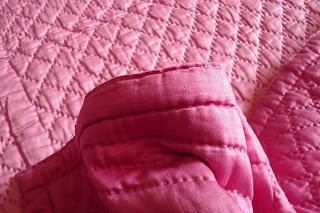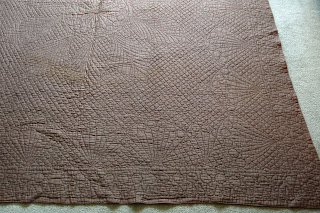In the early 1990's, the US military Bases at Woodbridge and Bentwaters were open and five of us quilters met fortnightly - Kay and Shirley from the base, and Pat, Madelaine and myself. We would each take it in turn to teach a technique or run an exercise of some sort. We brought food to share, which resulted in some interesting and unbalanced meals!
I don't remember how, but we met Suzi McFarland, who lived in Ipswich and had some museum quality quilts. She and a business partner had run an antiques shop in Carlisle, and sold quite a few quilts there. She still had a few, so one day I went along to her house to see what she had left of the old stock - not much - some rather uninspiring utility patchwork - but I came away with three Durham wholecloths. Even then, I was interested in the quilting! This is one of the three quilts.
By the way, Suzi used to just pitch the Durhams in the washing machine and peg them out on the line in her backyard - apart from some notches where the pegs had been, they all came out great - these old quilts must be made of iron.

This is "country" quilt. It is made of cotton sateen and is a large quilt (79 x89 inches). It has cotton wadding but is a lightweight quilt. It has obviously been well used but someone was proud of it, I'm sure.

The design is rather home made, the quilter has not used the usual templates, but made up her own, the main one is this "palm leaf" motif.

In the centre of the quilt is this horse shoe in a small diamond. Perhaps, like the Suffolk farmhouses, there were horseshoes around - a symbol of luck - or perhaps a wedding quilt? This seems to have been traced as it is life sized - also, don't know if you can see, everything was traced around objects with a heavy pencil marking - many, many washings have not obliterated this pencil (let that be a warning to you!)

The crosshatching is wonky, to say the least - distinctly wavy - and yet the eye tries to make it straight...

The quilter also went into the garden and collected leaves to serve as patterns - this is a sycamore leaf - again traced in heavy pencil...

...and an elder leaf or other compound leaf ......

The corner where you can see the machine stitching along the edge.
There are two slightly different shades of pink.

A final photo to show the VERY heavy pencil markings on this quilt. One gets the feeling that this quilter didn't have much to work with, but still made a quilt which is charming and very much in the north country idiom.


















































